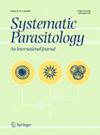巴西Caatinga Spelaeorhynchus前体新记录Neumann, 1902(中类群:Spelaeorhynchidae)。
IF 1
4区 医学
Q4 PARASITOLOGY
引用次数: 0
摘要
新热带蝙蝠外寄生虫科(Spelaeorhynchidae)包括7种于一属。前体Spelaeorhynchus在该地区分布最广,寄生于卡洛琳亚科、舌蝇亚科和窄皮蝇亚科的层状蝙蝠。本研究扩大了该物种已知的地理分布,提供了新的寄主记录,以及第一张详细描述该物种主要特征的SEM图像。本文章由计算机程序翻译,如有差异,请以英文原文为准。
New records of Spelaeorhynchus praecursor Neumann, 1902 (Mesostigmata: Spelaeorhynchidae) in the Brazilian Caatinga.
The Neotropical bat-ectoparasite family Spelaeorhynchidae comprises seven species into in one genus. The species Spelaeorhynchus praecursor is the most distributed in the region, parasitizing phyllostomid bats of the subfamilies Carolliinae, Glossophaginae and Stenodermatinae. The present study expands the known geographic distribution of this species, providing new host records, as well as the first SEM images detailing the main characteristics of this species.
求助全文
通过发布文献求助,成功后即可免费获取论文全文。
去求助
来源期刊

Systematic Parasitology
医学-寄生虫学
CiteScore
2.20
自引率
23.10%
发文量
64
审稿时长
6-12 weeks
期刊介绍:
Systematic Parasitology publishes papers on the systematics, taxonomy and nomenclature of the following groups: Nematoda (including plant-parasitic), Monogenea, Digenea, Cestoda, Acanthocephala, Aspidogastrea, Cestodaria, Arthropoda (parasitic copepods, hymenopterans, mites, ticks, etc.), Protozoa (parasitic groups), and parasitic genera in other groups, such as Mollusca, Turbelleria, etc. Systematic Parasitology publishes fully illustrated research papers, brief communications, and fully illustrated major revisions. In order to maintain high standards, all contributors describing new taxa are asked to state clearly where the holotype is deposited and to make paratypes available for examination by the referees. It is recognized that, in some cases, this may cause problems for the authors, but it is hoped that by adhering to this rule authors may be protected against rapid synonymy of their taxa, and the types will be preserved for posterity.
 求助内容:
求助内容: 应助结果提醒方式:
应助结果提醒方式:


